Acoustic Guitar
Installing the system on the instrument
Model J48C, volume wheel option:
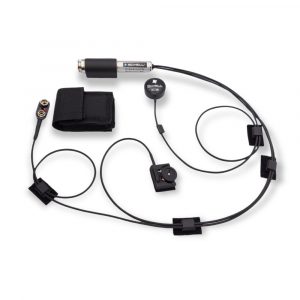
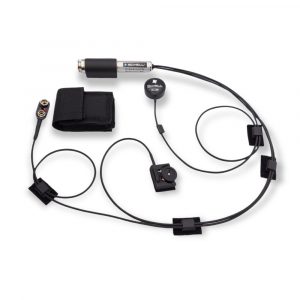

- System J48C removably installs on the guitar.
- Plan your cable route and system placement.
- Clean the bonding spots. The location of the microphone must be clean, smooth and dust-free, lint-free.
- The transparent double-sided provided is quite powerful but can be used on a recent varnish in good condition without damaging it. Try it out. Turn the part to take it off. Cut small pieces suitable for the part of the microphone kit with good scissors and avoiding touching the sticky part as much as possible. Replace it after each test.
- If necessary, carry out your first tests without fixing the system so that you can easily adjust the low cut if necessary.
- Secure the Jack on the splice at the bottom of the neck so that the entry is at the edge of the back of the guitar. Use the transparent double-sided provided. A connecting cable with a Jack elbow is required to connect.
- Route the cables along the handle using 3 cable ties fixed with the double face.
- Attach the 9v battery pouch inside on the heel of the neck, on the rib or on the back of the guitar if the heel is rounded.
- Attach the volume dial if you have the option, inside, at the edge of the soundhole, bass side, so that only the dial protrudes.
- Secure and retract the excess cable inside using the cable ties provided. You can make loops with the 3-wire pliers.
- Place the contact microphone in the desired location, a cable tie at 3 cm with a little putty adhesive then make your first tests. Adjust the mic placement if necessary several times. See below.
- If you subsequently wish to install the system in a fixed manner, it is possible, you just have to remove the mounting plate from the Jack and follow the directions below.
“Inside” model J48C, volume wheel option:
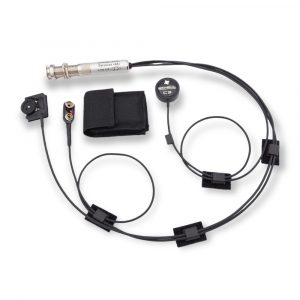
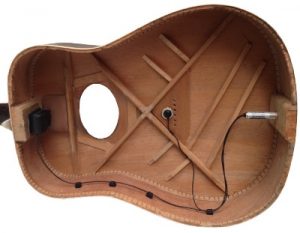
- This model is fixed inside with drilling for the Jack
- Plan your cable route and system placement.
- Clean the bonding spots. The place of installation of the microphone must be clean, smooth and free of lint, not dusty.
- If necessary, carry out your first tests without fixing the system so that you can easily adjust the low cut if necessary.
- Place the contact microphone in the desired location, a cable tie at 3 cm with a little putty adhesive then try. Adjust the mic placement if necessary several times. See below.
- Then drill the guitar at 12 mm, place the cable ties in the right place on the cables then fix the Jack Drilling an instrument and installing the Jack
- Attach the pocket of the 9v battery inside on the heel of the handle, on the splice or under the handle if the heel is rounded.
- Attach the volume dial if you have the option, inside, at the edge of the soundhole, bass side, so that only the dial protrudes.
- Secure and retract the excess cable inside using the cable ties provided. You can make loops with the 3 cable ties.
CPJ microphone kits APJ-ACPJ-AAPJ:
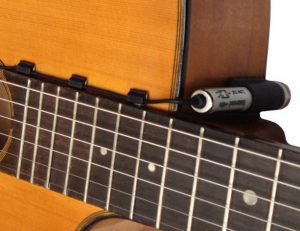
- Plan your cable route and system placement.
- Clean the bonding spots. The place of installation of the microphone must be clean, smooth and free of lint, not dusty.
- The transparent double-sided provided is quite powerful but can be used on a recent varnish in good condition without damaging it. Try it out. Turn the part to peel it off. Cut small pieces suitable for the part of the microphone kit with good scissors and avoiding touching the sticky part as much as possible. Replace it after each test.
- Secure the Jack on the splice at the bottom of the neck so that the entry is at the edge of the back of the guitar. Use the transparent double-sided provided. A connecting cable with a Jack elbow is required to connect.
- You can use putty adhesive to fix the Jack and cable ties on very fragile varnishes, but it is much less stable.
- Then follow the cables along the handle using 3 pliers 3 cables.
- Immerse the cables in the rosette, fix the microphone then retract the excess cable inside using the cable ties provided. You can make loops with the 3-wire pliers.
- Place the contact microphone in the desired location, a cable tie at 3 cm with a little putty adhesive then make your first tests. Adjust the mic placement if necessary several times. See below.
- The aerial microphone is fixed with the double sided or putty adhesive for very fragile varnishes or when placed inside.
CJ-AJ-ACJ-AAJ microphone kits:
- Plan your cable route and system placement.
- Clean the bonding spots. The place of installation of the microphone must be clean, smooth and free of lint, not dusty.
- Drill the guitar at 12 mm
- Place the cable ties in the right place on the cables then fix the Jack Drilling an instrument and installing the Jack
- Place the contact microphone in the desired location, a cable tie at 3 cm with a little putty adhesive then try. Adjust the mic placement if necessary several times. See below.
- Secure the aerial microphone with the double sided or putty adhesive for very fragile varnishes or when placed inside. See below.
Positioning of the contact microphone
- As a reminder, it is important to properly prepare your contact microphone for installation, do not hesitate to reread the advice below depending on your model:
- Original C1 contact microphone preparation page
- C2 and C3 contact microphones preparation page
- The default placement is between A and D precisely under the nut, the adhesive putty of C1 almost touches the cheCitys used to fix the strings, the same for C2 and C3.
- Make your first attempts. Generally the tonal balance is good, but if you notice a flagrant imbalance with a lack of power of the high strings for example, then move the microphone towards the highs and vice versa. By default always stay precisely under the nut. If you move away from it you may hear disproportionately the sliding of your fingers on the strings.
- Your system is equipped with a low cut. The default position for the Folk guitar is 180Hz, you can start your practice at this position. If after determining the best placement for the string power balance you find the sound lacks bass, then set the low cut to Flat. If you find that the sound lacks treble, set it to 360Hz.
- If you find the sound to be too bright, put the mic back in the same spot with the gray putty which sounds duller in the highs and rounder in the bass.
- Adjust the compression if necessary to correct the problems of difference in power of notes, strings but also too present harmonics. C1 by re-pressing it, C2 and C3 by removing a little adhesive putty.
- Check once the microphone has been placed definitively that the adhesive putty does not interfere with the extraction of the cheCitys.
- For a Lowden type guitar with a 2-part nut, the balance is generally found by placing the microphone at the end of the bass side dam, at the level of the nut, which corresponds on the outside to a placement on the bridge just above the bass strings.
- For a Martin D18, the basic position with the C3 is in the center of the bridge between the two cheCitys of Ré and Sol, advanced towards the 3mm Coupe bas nut set to Flat. audio putty 3g.
- For a Martin D28, the basic position with the C3 is above the last bass cheCity, advanced towards the nut by 3mm, 3mm from the X bracing which passes there. Low Cut set to Flat. putty audio 3g
- For a Taylor 700 series, on the reinforcement behind the bridge, 2cm from the cheCity at the level of the high E. The microphone is a few millimeters from the rear bracing that goes up towards the bass. Adjust the tonal balance by going up to the bass or going down to the treble. putty 2.5 to 3g
Positioning of the aerial microphone (s)
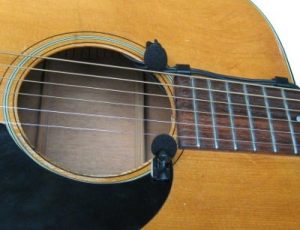
- The default position is at the bottom of the neck at the edge of the rosette, treble side, always perpendicular to the strings, the microphone grid 1 cm from the strings. Secure it with the double-sided or putty adhesive for very fragile varnishes.
- Depending on your playing and the sound you are looking for, you can put it more towards the neck (less bass) or more towards the center of the soundhole (more bass).
- In the case of a kit with two aerial microphones, place them in perfect opposition as in the photo.
- The low cut position for overhead mics is always 360Hz, your system is delivered to you in this position.
Stage use
Using the contact microphone:
- Allows high levels face / returns, easy use on amp.
- Use of effects pedals, loopers with loops without repisse ...
- Contact microphone + Aerial on noisy stages, put only the contact microphone in return and on the front panel 60% contact and 40% aerial.
Common equalizations with the aerial microphone:
- Reduce the bass if necessary below 200Hz
- Make a dip around 400 / 500Hz (recurring).
- On oversized subsystems, add a low cut.
- On some systems, reduce the treble slightly.
Some of the ways to use a 2X48 + AAPJ or AAJ on a folk guitar:
- You have two microphones available. One takes slightly more bass, the other slightly more treble. The two pickups both benefit from an overall pickup of the sound of the guitar with these few differences.
- You can use the stereo in concert, for that open the panoramas at 9:15 am. This allows you to gain a few dB of power and gives a very wide sound. However, the addition of the two microphones has a bass boosting effect, so you will surely have to put a low cut on each line. In this case, only one microphone must be returned; choice of bass or treble.
- A second possibility of use which offers good advantages and is easier to manage, is to use only the low microphone in return and only the high microphone for the face. The sound management is simpler and allows good levels face / returns.
- Return the sound of a single microphone except in the case of 2 separate returns positioned in stereo. Choose one, bass or treble as the musician chooses.

